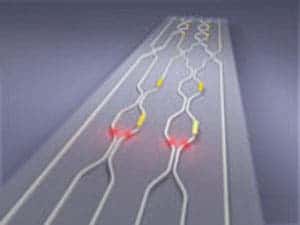
Scientists at University of Bristol‘s Centre for Quantum Photonics have remarkably managed to create a multi-purpose optical chip capable of manipulating and measuring quantum entanglement and mixture – two important quantum effects which have been giving researchers headaches for a long time, but which can now be controlled and used to characterize quantum circuits. This is a considerable leap forward in the race for developing the first working quantum computer.
Controlling quantum entanglement, a phenomenon which describes the interaction of two distant particles as a pair, is fundamental to developing quantum computers. Bristol researchers have shown that this phenomenon can be generated, manipulated, and most importantly, measured all on a tiny silica chip.
“In order to build a quantum computer, we not only need to be able to control complex phenomena such as entanglement and mixture, but we need to be able to do this on a chip, so that we can scalably and practically duplicate many such miniature circuits—in much the same way as the modern computers we have today,” says Professor Jeremy O’Brien, Director of the Centre for Quantum Photonics. “Our device enables this and we believe it is a major step forward towards optical quantum computing.”
The chip, measuring a mere 70 mm by 3 mm, consists of a network of tiny channels which guide, manipulate and interact single photons in a sequence of operations which would ordinarily be carried out on an optical bench the size of a large dining table. Using eight reconfigurable electrodes embedded in the circuit, photon pairs can be manipulated and entangled, producing any possible entangled state of two photons or any mixed state of one photon.
“It isn’t ideal if your quantum computer can only perform a single specific task. We would prefer to have a reconfigurable device which can perform a broad variety of tasks, much like our desktop PCs today — this reconfigurable ability is what we have now demonstrated,” says Peter Shadbolt, lead author of the study.
[RELATED] The age of nano-electronics: scientists develop one of the world’s smallest circuits
“This device is approximately ten times more complex than previous experiments using this technology. It’s exciting because we can perform many different experiments in a very straightforward way, using a single reconfigurable chip.”
The quantum photonic chip is the product of six years of hard work development, and now researchers are hoping they can scale and replicate it such that they might build the building block for the future’s long sought quantum computers.
“Being able to generate, manipulate and measure entanglement on a chip is an awesome achievement,” says Dr Terry Rudolph from Imperial College in London, UK,.
“Not only is it a key step towards the many quantum technologies — such as optical quantum computing — which are going to revolutionize our lives, it gives us much more opportunity to explore and play with some of the very weird quantum phenomena we still struggle to wrap our minds around.”


